Day Trips from Paris: Cinderella’s Fairytale at Château de Chaumont
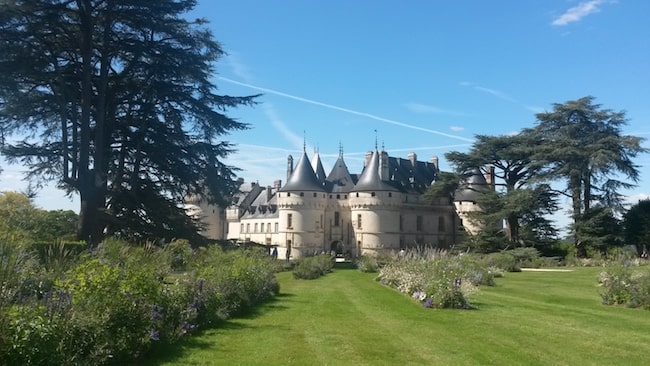

- SUBSCRIBE
- ALREADY SUBSCRIBED?
BECOME A BONJOUR PARIS MEMBER
Gain full access to our collection of over 5,000 articles and bring the City of Light into your life. Just 60 USD per year.
Find out why you should become a member here.
Sign in
Fill in your credentials below.
It might be slightly off the beaten track, but this majestic turreted château, hiding away in the secluded village of Chaumont-sur-Loire, is none other than the original inspiration for the iconic fairytale Cendrillon – or, in English, Cinderella.
If, in the aftermath of the coronavirus, you’re seeking an escape from the crowds, Château de Chaumont promises to fit the bill. In fact, it’s one of the most under-rated day trips from Paris in existence.
Just a short taxi ride from Onzain train station is the location that, in 1697, allegedly tempted fairytale author Charles Perrault to create Cinderella – an abused girl betrayed by her father and forced into drudgery at the hands of her wicked step-family. Here in the heart of the Loire Valley, he decided, was the location where she would languish, trapped and compelled to do menial tasks. After each long day, she would slump exhausted in front of the fireplace where, filthy from stoking the hot coals, she would fall into a deep sleep – before it all began again the next morning.
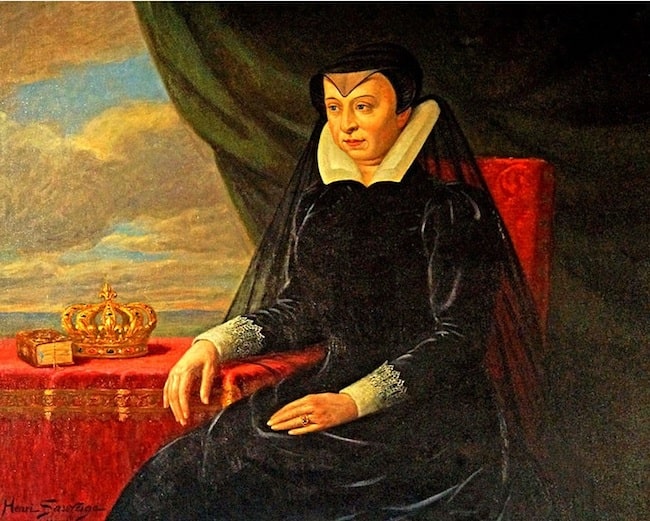
The evil queen Catherine de Medici who some believe part-inspired the-characters in Cinderella’s-step-family for Perrault’s fairytale
It is not difficult to imagine why Perrault might choose this château as the backdrop for poor Cinderella’s fate. After all, little more than a century earlier, a real-life sadistic woman had reigned there – the cruel 1500s Queen Catherine de Medici. Scandals had swept through history, portraying her as a satanist who took part in black magic rituals and a serial killer who surreptitiously murdered her victims by lacing their perfumed gloves with poison. These haute couture fashion items could never be seen as innocuous while Medici was around. In fact, the ‘common-folk’ would even joke at their good fortune that they were not wealthy enough to buy them!
Besides the rumors that she had attended a secret school to train in the art of mixing poisons, and the public distrust at her “occultist” interests in astrology and astronomy, she was also controversial for her ownership of a so-called “circus curiosity”, Petrus Gonsalvus. Suffering an unusual appearance due to the excessive hair growth condition hypertrichosis, he was kept like a caged animal and relentlessly abused.
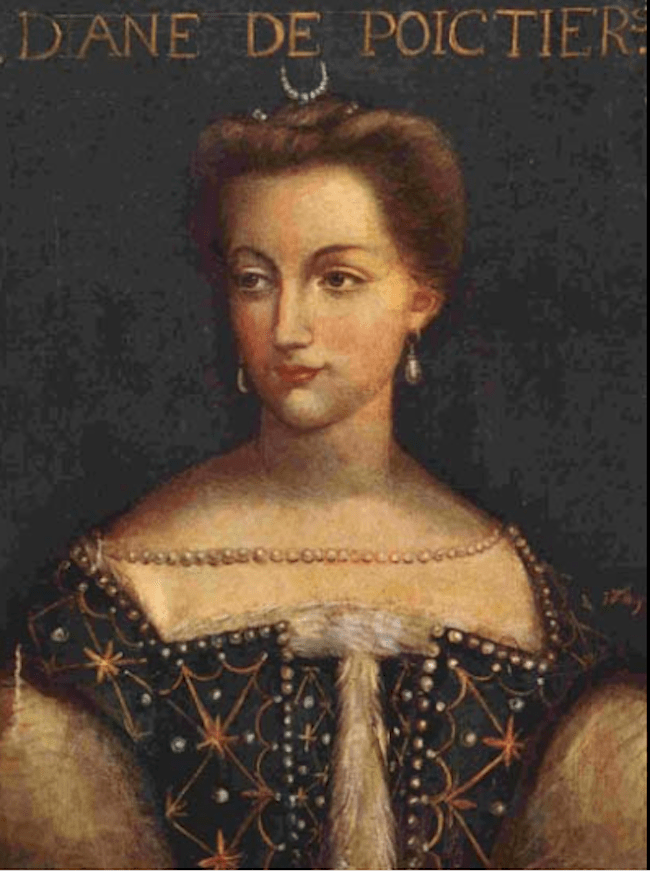
Diane de Poitiers the King’s mistress who some believe part-inspired the character of Cinderella
The ultimate cruelty, however, was allegedly dished out to her husband King Henri II’s mistress, Diane de Poitiers. The real love of his life, in stark contrast to the lack of affection in his cold and emotionless arranged marriage, she was never liked. After the King’s death in 1559, Medici attempted to banish her from Château de Chenonceau and annex her at Château de Chaumont, so that she could claim all the larger and more lavish châteaux in the region as exclusively her own. Diane de Poitiers proudly declined, opting instead for the less renowned Château d’Anet more than 100 miles away, and she only returned to Chaumont on rare occasions.
Yet according to rumors, abuse towards Diane made her the real-life Cinderella who had set sparks flying in Perrault’s imagination – and while Château de Chaumont might have seemed the last choice at the time, favored by neither of the King’s ladies, today a trip here is absolutely unmissable.
Visitors can explore the history of the infamously bloodthirsty Medici via a room bearing her name, with mermaids and warrior symbols built into the bed chamber. Others such as the Ruggieri room have tell-tale signs of Medici’s presence too – it was named after one of her favorite astrologers. Meanwhile the Greek letter Delta in a sign on the mantelpiece represents Diane’s initial and the moon symbols surrounding it are a nod to Diane the moon goddess in Roman mythology.
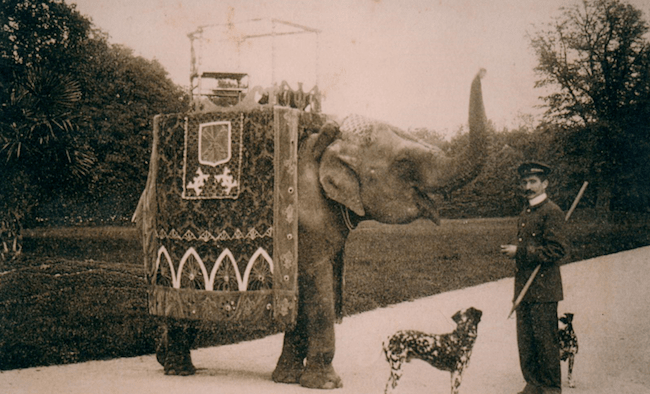
An elephant gifted to the château by an Indian Maharaja in 1898. Photo courtesy of Château de Chaumont
These small touches in the decor reveal a lot about Diane’s psychology and her background knowledge of Greek and Latin. Plus in later years other royals resided here, such as the de Broglie family. Once an elephant roamed on the château’s grounds after it was gifted to Princess de Broglie by an Indian Maharaja in 1898. However the voraciously hungry beast apparently “ate her out of house and home” and had to be banished in disgrace to the Jardin des Plantes eight years later! Fortunately conditions there had improved since the time of the 1870 Paris siege though, when locals resorted to eating the animals kept at the zoo. Those staying in the area for their train journey from Gare d’Austerlitz to Gare d’Onzain to visit the château may wish to stop by at the Jardin des Plantes, perhaps the next day – it’s a mere two minute walk from Austerlitz. It goes without saying, of course, that there are no wild elephants on the loose there!
Besides their eyebrow-raising ownership of exotic animals, the Broglie family was also apparently the first to add electric lamps to their stables when no other château in the region had such modern touches.
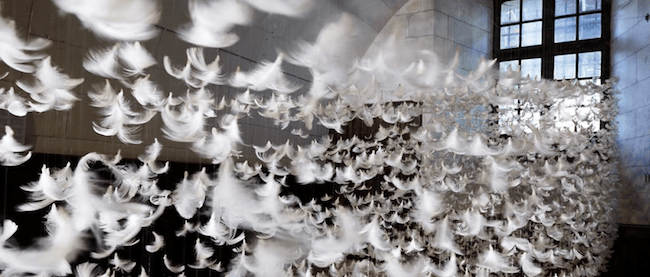
Modern art at the château. Feather art installation for 2020 by Isa Barbier. Photo courtesy of Château de Chaumont
However, it’s not exclusively history here. Château de Chaumont is also unique among all of the Loire Valley châteaux for its commitment to mixing ancient tradition with modern style. Dubbing itself a “living château”, it dedicates rooms here to the display of modern art and sculpture, with even the Bee Barn and Stables now utilized for the purpose. A new art season is presented each year – and the themes are by no means predictable or staid. For instance, Japanese creator Makoto Azuma presents a herbarium for 2020 “featuring real flowers coated with a transparent resin to give them eternal life”, while a spectacular feather installation appears courtesy of Isa Barbier.
There is also an annual garden festival where entire garden scenes are brought to life based on creative themes. For example, last year saw a ‘Garden of Eden’ display by Philippe Collignon and David Bitton which took guests on a near-biblical journey through the after-life.
It portrayed that in order to reach Paradise, one must first experience a type of death. Consequently visitors were led through a black entrance, surrounded by jet black walls and curtains that no light could penetrate. This was a symbolic representation of the tunnel of death, and – in the context of Cinderella – perhaps mimicked the dark feelings of her entrapment. The repetitive cycle of drudgery, then slumbering at the fireplace, staring hypnotically into the dark coals before falling into deep sleep.
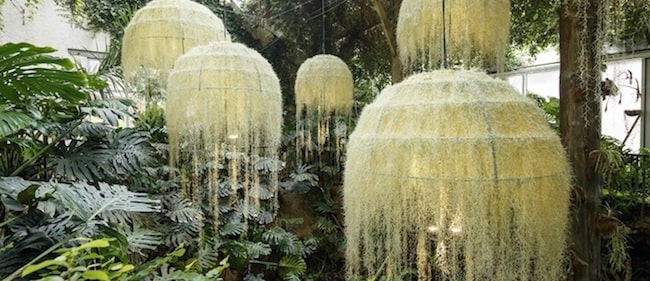
Rainforest Garden at Château de Chaumont Greenhouse
Visitors then passed into the “afterlife”, leaving the darkness behind to reach Heaven. As they continued walking, the curtain led them to Eden, transforming the landscape with swathes of colorful flowers, victorious music and chirping bird song. In the designers’ minds, this was the Paradise promised by religious texts – and, bearing in mind the château’s fairytale history, it could also symbolize the rebirth and transformation of Cinderella when she escaped her former life to appear in her jeweled gown at the ball. She was obliged to find a way to kill off her old life of drudgery to transform. If we interpret death and rebirth symbolically rather than literally, then the two themes match.
2020 promises many more new creative ideas to enjoy and interpret too, making a visit here an essential to schedule in for summer. With the title “Return To Mother Earth,” dozens of gardens boasting everything from mandala and meditation themes to an amusingly incongruent chicken coop guarantee a full program post-restrictions.
The creative themes even continue in the design of the food, should you be tempted to take a bite to eat. Last year, the menu included a dish visually and symbolically based on the Tree of Life. Château de Chaumont is the only one in the Loire Valley to continually refresh artistic themes, combining new and old for an environment that simultaneously both honors its past and yet never stands still.
The site can easily occupy visitors over a full day, although, that said, it’s also worth setting some time aside to visit the nearby Domaine Hauts de Loire.
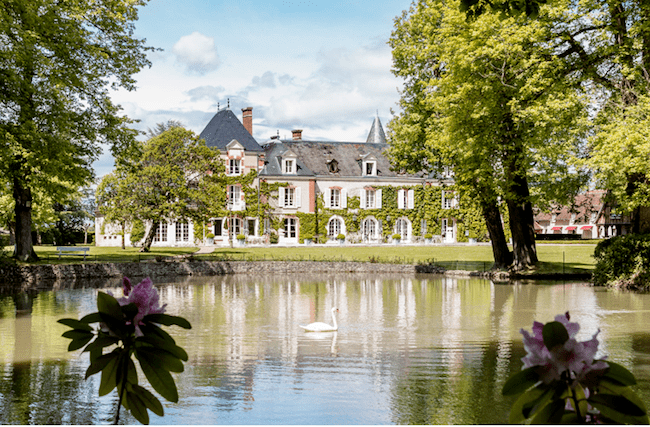
Hauts de Loire, overlooking a swan-filled lake. Photo courtesy of Hauts de Loire
The closest luxury property and a fairytale château in its own right, its façade is covered in dramatic shrubbery and vines – and it’s a mere ten minute drive away. Besides a swan-filled lake, 70 hectares of sweeping park and forest land, a tennis court, swimming pool and even a Clarins spa, the dining options are first class. The two starred Michelin restaurant is run by chef Remy Giraud, who has spent the last three decades dedicating himself to the kitchens here. His menu options include Sologne caviar, eel salad and hare terrine a la royale. Fruits and vegetables could scarcely be more locally sourced, hand-picked as they are from the garden overlooking the restaurant. There are also beehives on site producing delectable honey which is served to all over-night guests at the breakfast table. Finally the property produces its own chocolate, courtesy of on-site pastry chef Cedric Noel. A meal here is the perfect way to wind down after a busy day at the château while for a lighter choice there’s also a bistro – and after indulging, guests could still be back in the city before the end of the evening.
By train, a service runs from Paris Austerlitz to Onzain, followed by a short taxi ride to complete the journey to the château. Some services are much quicker than others, so be sure to pick the most optimal time. Traveling by car, on the other hand, is a more convenient option and it opens up access more easily to the surrounding countryside. Be sure to set the sat-nav for ‘Chaumont-sur-Loire’, not ‘Chaumont’, as the latter could land you in Champagne territory. Although there are certainly worse areas to find yourself in, it will prove an unhappy diversion for those with their hearts set on the château!
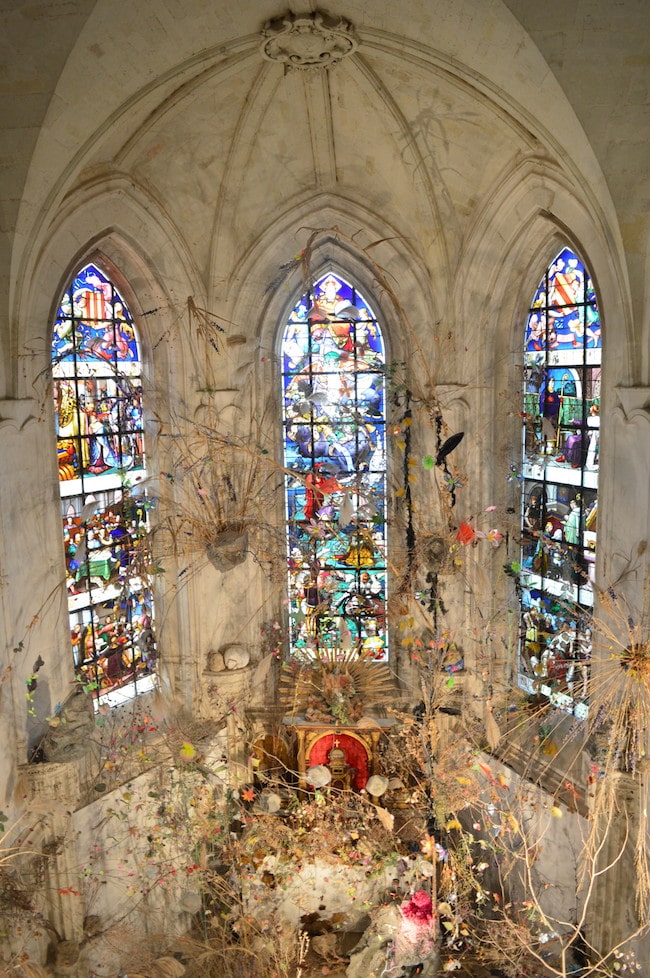
Stained glass windows dating back to 1888 at the Château de Chaumont Chapel by Chloe Govan
The site recommends allowing enough time for your pick of:
> 32 hectares of grounds
> 55 contemporary art installations and exhibitions
> 30 new gardens
> the fully refurnished Château, the Stables and the Historical Park
With this in mind, the earlier you can set off, the better!
Price: €19 for a single day ticket, €6 for the under-12s and €38 for a family ticket.
Accessibility: Free admission for the disabled.
Website: http://www.domaine-chaumont.fr/
Les Hautes de Loire Website: https://www.hautsdeloire.com
A final word – this château seems at times to have been almost as neglected as the fictional Cinderella herself, all too often passed over in favor of more well-known, more centrally located or flashier châteaux. Yet, while it might lack the opulent decor of Versailles or the notoriety of Chambord, it would be a huge mistake to dismiss this hidden gem. Few speak of the associations with Cinderella, let alone its vast history and existence even before Medici was born. Yet a slight detour from the beaten track will reap real rewards – and it’s even believed that this château was one of those that inspired work on the Disney movie version of Cinderella too. This is a highly recommended day trip which you might still be reminiscing over for half the summer!
Lead photo credit : Château de Chaumont by Chloe Govan
More in Chateau de Chaumont, Cinderella



REPLY